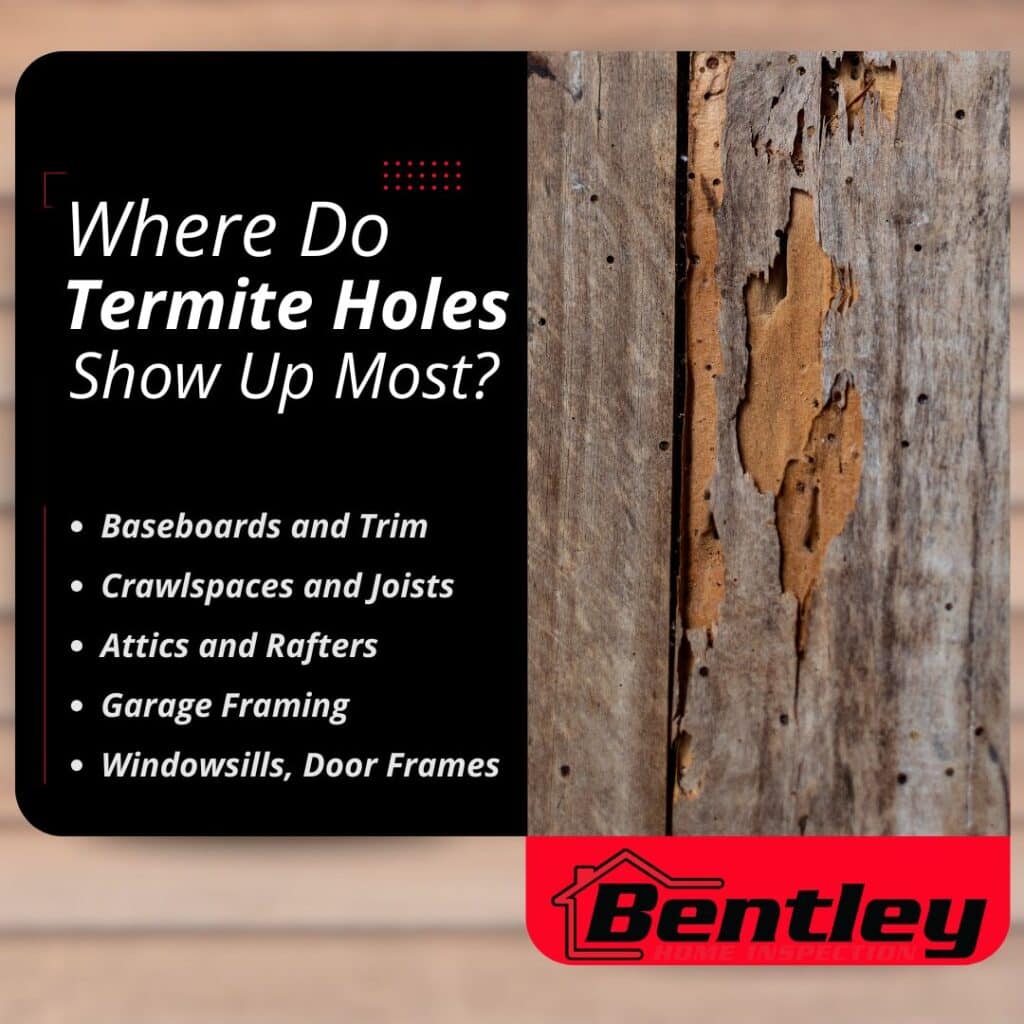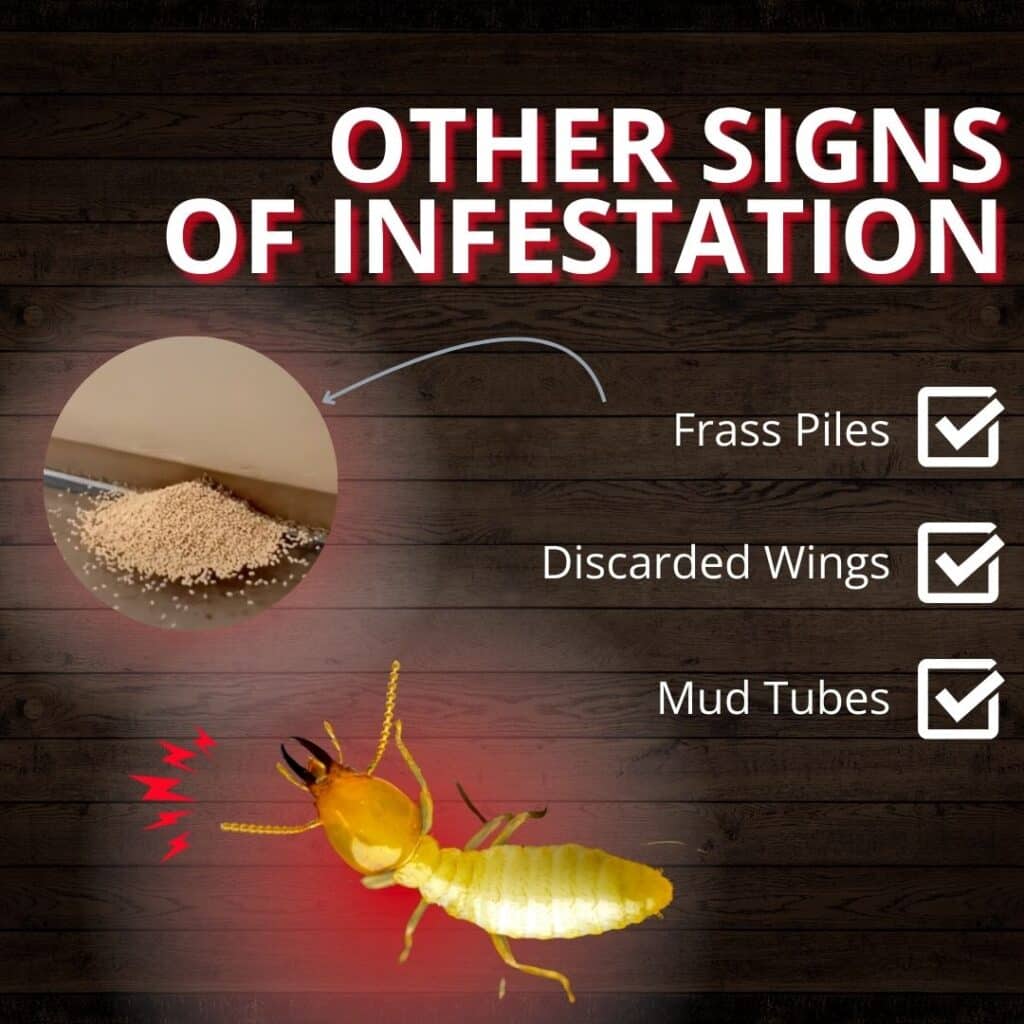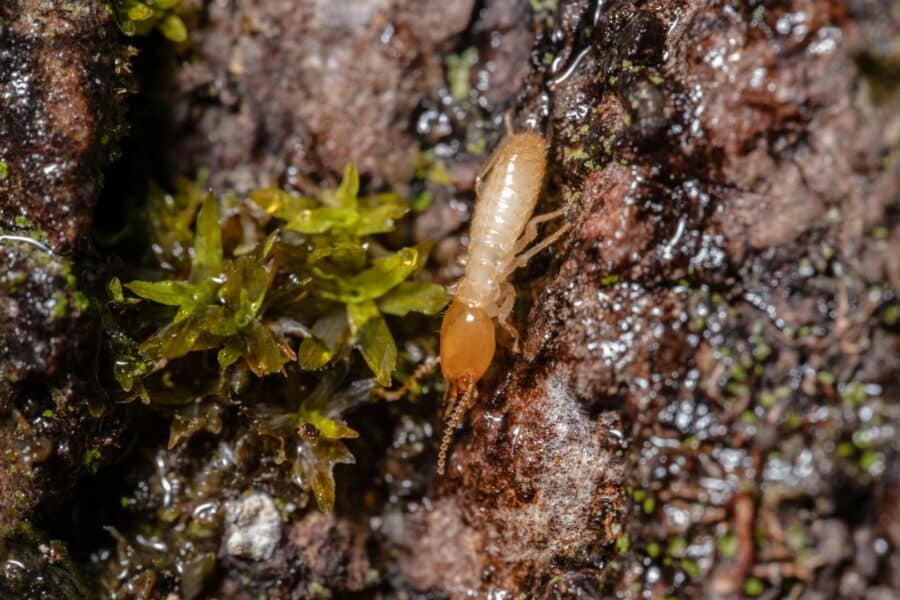
Tiny holes in your walls or wood trim might not seem like a big deal. But in the right conditions, those openings can signal something far more serious: a termite problem hiding just beneath the surface. Termite holes are often one of the first signs that lead inspectors to uncover bigger issues in a home’s structure.
Whether you’re buying, selling, or just want to protect your investment, understanding how termite holes form, what they look like, and how inspectors find them can help you make smart decisions about your property.
What Termite Holes Actually Look Like
One of the most misunderstood parts of termite damage is what it looks like from the outside. Homeowners often confuse termite holes with nail holes, wood rot, or even just natural wood grain. But there are a few key differences a trained eye will notice.
Typical features of termite holes:
- Very small and round (about the size of a pinhead)
- Appear in dry, unfinished wood or near baseboards and corners
- Often surrounded by fine dust or “frass” (termite droppings)
- May appear in clusters or seemingly random locations
- Sometimes, it’s plugged with a waxy or soil-like substance by the termites themselves
Drywood vs. Subterranean termite holes:
Drywood termites tend to create more visible exit holes as they push out frass. Subterranean termites, which are more common in Tennessee, usually stay hidden and use mud tubes, so holes are often harder to spot.

Where Inspectors Look First
Professional inspectors don’t rely on guesswork. They know where termite activity tends to show up first, and they follow a systematic approach to finding it. Some of the first areas inspected include:
1. Baseboards and Trim
Even a single tiny hole in a doorframe or along the baseboard can signal an infestation. Inspectors tap gently along the wood to check for hollowness or soft spots.
2. Crawlspaces and Floor Joists
In Tennessee, many homes have crawlspaces that create the perfect environment for termites. Moisture, darkness, and exposed wood make this area a high-priority inspection zone.
3. Attics and Rafters
Though less common, attic wood can still become a target. Inspectors will check for holes, surface damage, and unusual wood dust patterns around beams.
4. Garage Framing
Garages often have exposed studs, sill plates, or headers that show damage earlier than interior finishes. This is a good place to catch damage before it spreads into living spaces.
5. Windowsills and Door Frames
Termites are drawn to entry points where wood may be softer or previously exposed to moisture. Holes around window trim are a classic early sign.
What Happens After Termite Holes Are Found
Finding holes is just the beginning. Here’s what typically happens next during an inspection:
1. Confirming the Source
Not every hole is termite-related. Inspectors may use moisture meters, borescopes, or infrared cameras to confirm whether termite activity is present behind the wall or trim.
2. Looking for Secondary Clues
Beyond the hole itself, inspectors also look for:
- Mud tubes running along walls or foundations
- Frass piles under exit holes
- Hollow-sounding wood when tapped
- Buckled paint or uneven drywall
- Discarded wings near windowsills
3. Evaluating the Extent of Damage
If active termites or historical damage is confirmed, the inspector will outline where the damage is, how severe it appears, and whether further assessment or treatment is needed.
4. Recommending Next Steps
In some cases, a termite inspection report may be provided. The team at Bentley Home Inspection can also recommend trusted pest control providers if treatment is needed, and we offer full home inspections that help buyers understand the full scope of any structural impact.
Termite Holes vs. Other Damage
It’s easy to mistake other types of damage for termite activity. Here’s how inspectors distinguish them:
|
Type of Hole or Damage |
Possible Cause |
How It Differs From Termites |
|
Small pinhole with frass |
Termites |
Confirmed by the presence of frass and tunnels |
|
Clustered tiny holes |
Wood-boring beetles |
Smaller in size, more uniform |
|
Irregular softwood |
Rot or moisture damage |
No frass or tunnels, usually spongy |
|
Clean round holes |
Nails, screws, or hardware |
Smooth edges, often evenly spaced |
Having a trained inspector is essential to avoid false alarms (or worse, missed infestations).

Other Related Questions Homeowners Ask
What are other signs of termite damage besides holes?
Look for buckling paint, hollow-sounding wood, mud tubes near the foundation, or piles of frass. These signs often appear before or alongside holes.
Can termite damage impact a home’s structure?
Yes. If left untreated, termites can weaken framing, floor joists, and support beams. Early detection helps avoid expensive structural repairs.
How often should homes in Tennessee be checked for termites?
At least once a year, especially in humid or wooded areas. Annual inspections help catch activity early before damage spreads.
Is it possible to buy a home that already has termite damage?
Yes, but it depends on the extent of the damage. A detailed inspection during a real estate transaction helps you understand what’s repairable before closing, and what may require negotiation or treatment.
What if I see signs of damage but no live termites?
Even if the infestation is no longer active, the damage may still need to be repaired. A professional can tell whether it’s old or current and what to do next.
When to Call a Professional
If you notice any unusual holes in wooden surfaces, trim, or framing, the best move is to schedule an inspection right away. Early intervention is key with termites. A professional inspector will know whether what you’re seeing is normal wear or the early signs of something serious.
Bentley Home Inspection provides both termite inspections and full home inspections across Eastern Tennessee. Our team uses the right tools, training, and experience to catch termite activity early, before it becomes a major repair project.
Whether you’re buying a new home, maintaining your current one, or selling soon, a detailed inspection offers protection and clarity.
Conclusion
Termite holes may be small, but they speak volumes. To the untrained eye, they might go unnoticed or be mistaken for minor cosmetic flaws. To a professional inspector, they can be the first clue in uncovering a serious infestation.
Understanding what termite holes look like, where they’re likely to appear, and how inspections are conducted helps you take control of your home’s condition. If you suspect anything unusual, don’t wait. Schedule online with Bentley today.


